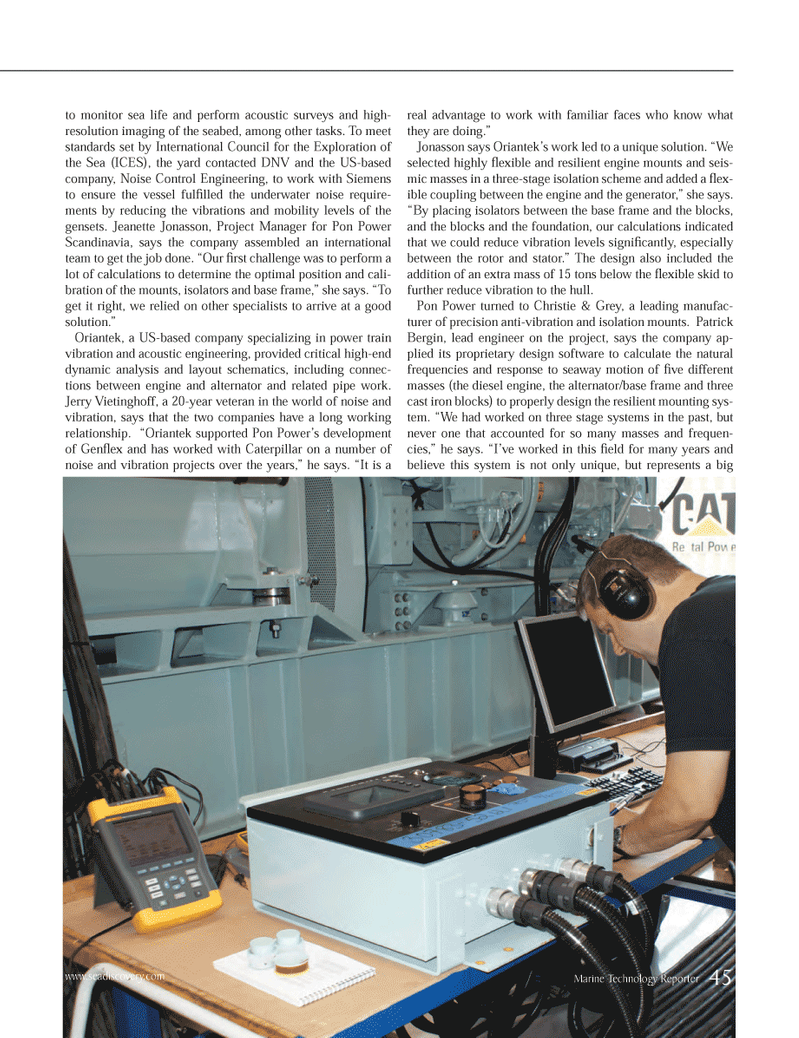
Page 45: of Marine Technology Magazine (April 2013)
Offshore Energy Report
Read this page in Pdf, Flash or Html5 edition of April 2013 Marine Technology Magazine
to monitor sea life and perform acoustic surveys and high- resolution imaging of the seabed, among other tasks. To meet standards set by International Council for the Exploration of the Sea (ICES), the yard contacted DNV and the US-based company, Noise Control Engineering, to work with Siemens to ensure the vessel fulÞ lled the underwater noise require- ments by reducing the vibrations and mobility levels of the gensets. Jeanette Jonasson, Project Manager for Pon Power Scandinavia, says the company assembled an international team to get the job done. ÒOur Þ rst challenge was to perform a lot of calculations to determine the optimal position and cali-bration of the mounts, isolators and base frame,Ó she says. ÒTo get it right, we relied on other specialists to arrive at a good solution.Ó Oriantek, a US-based company specializing in power train vibration and acoustic engineering, provided critical high-end dynamic analysis and layout schematics, including connec-tions between engine and alternator and related pipe work. Jerry Vietinghoff, a 20-year veteran in the world of noise and vibration, says that the two companies have a long working relationship. ÒOriantek supported Pon PowerÕs development of Genß ex and has worked with Caterpillar on a number of noise and vibration projects over the years,Ó he says. ÒIt is a real advantage to work with familiar faces who know what they are doing.Ó Jonasson says OriantekÕs work led to a unique solution. ÒWe selected highly ß exible and resilient engine mounts and seis- mic masses in a three-stage isolation scheme and added a ß ex- ible coupling between the engine and the generator,Ó she says. ÒBy placing isolators between the base frame and the blocks, and the blocks and the foundation, our calculations indicated that we could reduce vibration levels signiÞ cantly, especially between the rotor and stator.Ó The design also included the addition of an extra mass of 15 tons below the ß exible skid to further reduce vibration to the hull. Pon Power turned to Christie & Grey, a leading manufac- turer of precision anti-vibration and isolation mounts. Patrick Bergin, lead engineer on the project, says the company ap- plied its proprietary design software to calculate the natural frequencies and response to seaway motion of Þ ve different masses (the diesel engine, the alternator/base frame and three cast iron blocks) to properly design the resilient mounting sys-tem. ÒWe had worked on three stage systems in the past, but never one that accounted for so many masses and frequen- cies,Ó he says. ÒIÕve worked in this Þ eld for many years and believe this system is not only unique, but represents a big www.seadiscovery.com Marine Technology Reporter 45MTR #3 (34-49).indd 45MTR #3 (34-49).indd 454/4/2013 11:28:24 AM4/4/2013 11:28:24 AM

 44
44

 46
46
